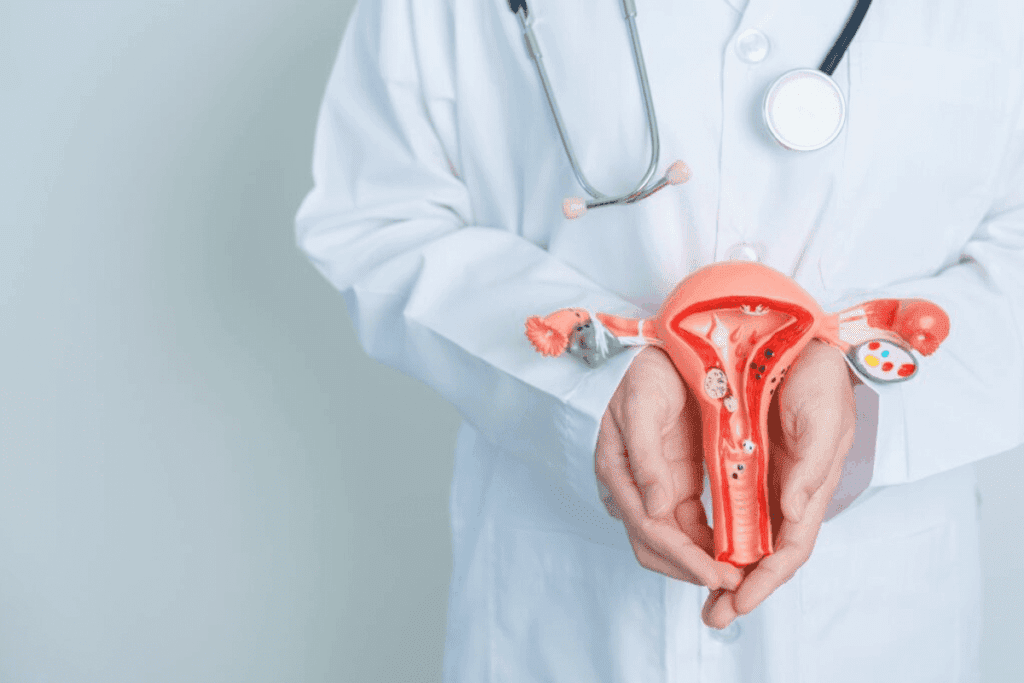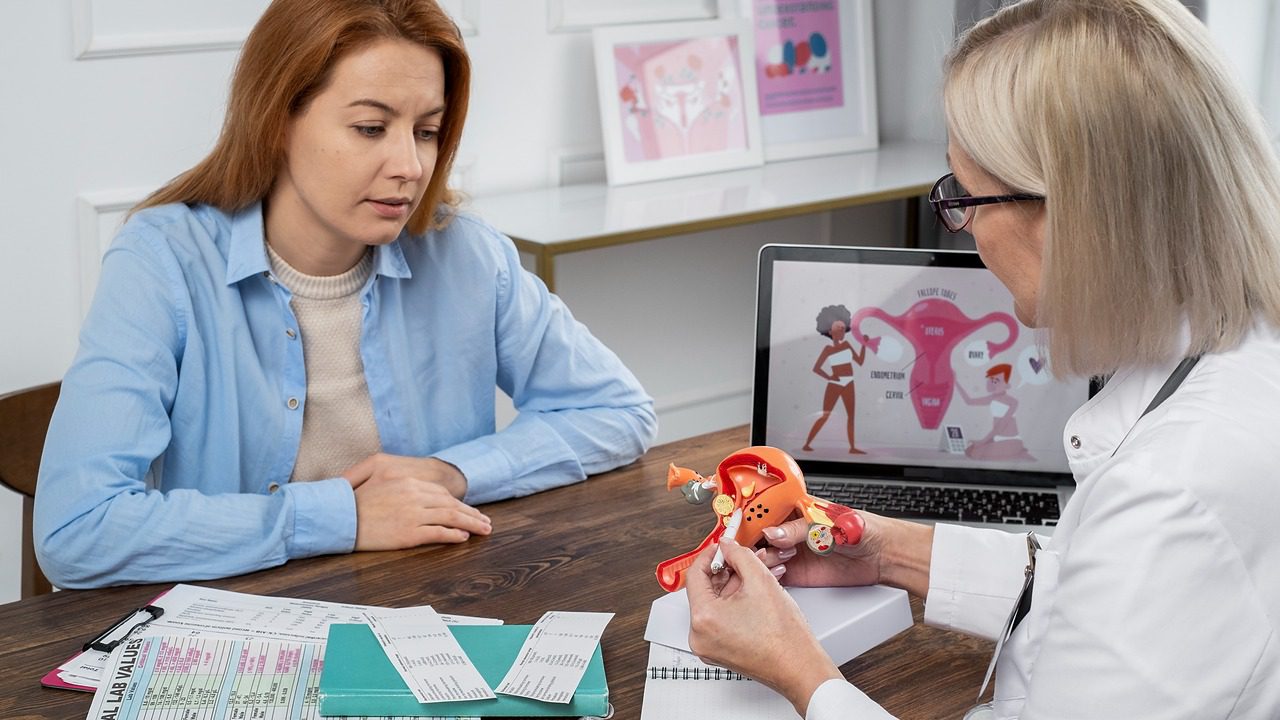Last Updated on November 24, 2025 by Ilayda Cengizhan
Adenomyosis is a condition that can really hurt women, making everyday life tough. It happens when the lining of the uterus grows into the muscle of the uterus adenomyosis disease.
When a woman has her period, this tissue gets thick, breaks down, and bleeds. This leads to many symptoms. Knowing about adenomyosis and its effects helps women choose the best treatment, like hysterectomy.

Adenomyosis is a health issue for many women. It happens when endometrial tissue grows into the uterine wall. This condition is marked by endometrial tissue in the myometrium, the uterus’s muscular wall.
Adenomyosis is when endometrial glands and stroma grow into the myometrium. This leads to heavy menstrual bleeding and pelvic pain. The pathophysiology of adenomyosis involves hormonal and inflammatory responses.
Adenomyosis and endometriosis both involve endometrial-like tissue growth. But they differ in where this tissue grows. Endometriosis grows outside the uterus, while adenomyosis grows within the uterine wall. Knowing this difference is key for diagnosis and treatment.
The exact cause of adenomyosis is unknown. But theories suggest it might be due to endometrial cells growing into the uterine muscle wall. This could be from surgeries like cesarean sections. Risk factors include prior uterine surgery, childbirth, and being in middle age. Studies show adenomyosis affects 1.03 percent of women in the United States.

It’s important for doctors to know who might get adenomyosis. This helps them find and help those at risk. Adenomyosis hits women of all ages and races, but some groups face higher risks.
Adenomyosis disease can happen at any age, but it’s most common in women 41 to 45 years old. This age group often shows the worst symptoms. This leads to more cases being found.
Studies show Black women are more likely to have adenomyosis. The exact reasons are unclear. It might be due to genetics, environment, or social factors.
Knowing these differences helps doctors create better treatments. This improves care for women with adenomyosis.
Adenomyosis disease symptoms vary among women, but common complaints are shared. This condition affects a woman’s quality of life through various symptoms.

Heavy and prolonged menstrual bleeding is a key symptom of adenomyosis. Women often have longer periods, sometimes over a week, with heavy flow. This can cause anemia and other health issues.
Adenomyosis disease also causes severe menstrual cramps and chronic pelvic pain. The pain is often deep and aching, making daily activities hard. It affects a woman’s overall well-being.
Adenomyosis disease can greatly affect fertility and pregnancy. Women may find it harder to conceive and face higher risks of miscarriage and preterm labor during pregnancy.
The symptoms of adenomyosis disease deeply impact a woman’s quality of life. Chronic pain and heavy bleeding lead to fatigue, anxiety, and depression. These symptoms make everyday tasks challenging.
| Symptom | Description | Impact on Women |
|---|---|---|
| Heavy Menstrual Bleeding | Prolonged and heavy menstrual periods | Anemia, fatigue, and social limitations |
| Severe Menstrual Cramps | Debilitating pain during menstruation | Daily activity limitations, emotional distress |
| Pelvic Pain | Chronic pain in the pelvic area | Constant discomfort, affecting overall well-being |
| Fertility Issues | Difficulties conceiving and pregnancy complications | Emotional distress, impact on family planning |
To diagnose adenomyosis disease, we use a mix of clinical checks, medical history, and advanced imaging. These tools help us spot the condition and tell it apart from other gynecological issues.
Transvaginal ultrasound is great for spotting adenomyosis. It shows signs like myometrial cysts and thickened junctional zones. But, how well it works depends on the skill of the person doing it and the quality of the ultrasound machine.
MRI is also a top choice for diagnosing adenomyosis disease. It gives clear images that show how far the disease has spread. MRI is key for planning treatment because it can show the disease’s extent well.
A detailed clinical evaluation and look at the patient’s medical history are key. We check symptoms like heavy bleeding, severe cramps, and pelvic pain. This helps us understand how bad the condition is and how it affects the patient’s life.
It’s important to tell adenomyosis apart from other conditions like endometriosis and uterine fibroids. We use imaging and clinical checks to make sure we get it right. This way, we can tailor treatment to what each patient needs.
Non-surgical treatments are great for managing adenomyosis disease. They help reduce symptoms and improve well-being. These options are good for women who want to keep their fertility or avoid big surgeries.
Hormonal therapies are key in treating adenomyosis disease symptoms. Birth control pills and other hormonal contraceptives can cut down menstrual bleeding and pain. They help balance hormones that cause adenomyosis disease symptoms.
These treatments can be customized for each patient. For example, progesterone-only treatments are good for women who can’t take estrogen-based contraceptives.
Managing pain is vital for women with adenomyosis disease. Pain relief medications, like NSAIDs, are often used to treat menstrual cramps and pain. They help improve quality of life.
Other pain management methods, like acupuncture and physical therapy, also offer relief. These methods focus on the patient’s overall health, not just symptoms.
Endometrial ablation is a procedure that aims to stop menstrual bleeding by removing the uterine lining. It’s often used for heavy bleeding but can also treat adenomyosis disease.
This procedure is for women who haven’t responded to other treatments or can’t take hormonal therapies. But, it’s not right for everyone, mainly those who want to keep their fertility.
Uterine artery embolization (UAE) is a minimally invasive procedure that helps manage adenomyosis disease symptoms. It blocks blood to the adenomyotic tissue, reducing pain and bleeding.
UAE is not risk-free but can be an alternative to surgery for some. Success rates vary, so it’s important to talk about the benefits and risks with a healthcare provider.
For women with severe adenomyosis disease, hysterectomy is often considered a definitive treatment option. This surgical procedure involves the removal of the uterus. It’s usually recommended for those who have not responded to other treatments or have completed childbearing.

There are several types of hysterectomy procedures that can be performed for adenomyosis:
The choice of procedure depends on the severity of adenomyosis disease, the patient’s overall health, and whether other reproductive organs are affected.
Hysterectomy is considered highly effective in treating adenomyosis disease. It eliminates the source of the symptoms by removing the uterus. “Hysterectomy provides a definitive solution for adenomyosis disease, giving relief from symptoms like heavy menstrual bleeding and pelvic pain.” Studies have shown that most women who undergo hysterectomy for adenomyosis see a significant improvement in their quality of life.
“Hysterectomy is a highly effective treatment for adenomyosis disease, providing symptom relief and improving quality of life for many women.”
Recovery from hysterectomy varies depending on the type of procedure and the individual’s health. Generally, women can expect:
It’s essential to follow post-operative instructions carefully to minimize complications and ensure a smooth recovery.
Hysterectomy is typically considered for women with adenomyosis disease who:
The decision to undergo hysterectomy should be made after thorough consultation with a healthcare provider. It’s important to consider individual circumstances and preferences.
Understanding how adenomyosis disease interacts with hormonal changes is key to managing symptoms. Hormonal shifts, like those during perimenopause and menopause, can greatly affect adenomyosis disease symptoms.
Perimenopause is a time of big hormonal changes. Adenomyosis disease symptoms can get better, worse, or stay the same. Some women might have heavier or more prolonged menstrual bleeding, while others might see a decrease in symptoms.
Women in this stage should work closely with their healthcare providers. Hormonal treatments and other interventions can help ease discomfort and improve life quality.
Menopause brings a big drop in estrogen levels. For many, adenomyosis disease symptoms improve after menopause because of this. But, not all women see their symptoms lessen.
Some women may keep experiencing symptoms due to leftover estrogen or hormone replacement therapy (HRT). It’s important for post-menopausal women with adenomyosis disease to talk to their healthcare provider about their symptoms and treatment options.
Adenomyosis disease is often treated with hysterectomy, the removal of the uterus. This surgery can help with symptoms, but it’s not a sure thing. Some women might continue to have persistent pelvic pain or other symptoms, possibly from other conditions.
After hysterectomy, it’s important to watch for any ongoing symptoms and address them.
Women who have gone through menopause might consider hormone replacement therapy (HRT) for symptoms. But, HRT can affect adenomyosis disease symptoms. Estrogen replacement therapy, in particular, can influence adenomyosis because it’s estrogen-dependent.
Women and their healthcare providers need to carefully consider the benefits and risks of HRT. They should look at how it might affect adenomyosis disease symptoms. Tailored HRT regimens and alternative treatments can help manage both menopausal symptoms and adenomyosis disease.
Living with adenomyosis means making lifestyle changes, trying medical treatments, and getting emotional support. It’s not just about treating symptoms. It’s about improving your life quality too.
Changing your lifestyle can help manage adenomyosis disease symptoms. Regular exercise, like yoga or walking, can lessen pain and boost your mood. Also, stress management techniques, such as meditation, can be helpful.
Your diet is key in managing adenomyosis disease. Eating anti-inflammatory foods like omega-3s, fruits, and veggies can help. Avoid foods that can make symptoms worse, like caffeine and processed foods.
Many women find relief with alternative and complementary therapies. Acupuncture and herbal remedies are good options. Always talk to a healthcare provider before trying new therapies to make sure they’re safe.
Dealing with adenomyosis disease can be tough, but you’re not alone. Joining support groups and talking to others who get it can offer emotional support and advice. Online forums and local groups are great resources.
“Connecting with others who have adenomyosis disease has been a game-changer for me. I’ve learned so much from their experiences and feel more empowered to manage my condition.”
By using these strategies every day, you can manage adenomyosis better and feel better overall. We’re here to support you and provide the resources you need to deal with this condition.
Understanding adenomyosis disease and its treatment options is key to making good choices about care. Managing adenomyosis well means looking at symptoms, wanting to have kids, and overall health. This approach helps find the right treatment.
Women have many ways to treat adenomyosis disease, from non-surgical methods like hormones and pain relief to surgery like hysterectomy. What works for one person might not work for another. This shows that treatment plans must be tailored to each person.
By thinking about what’s best for them, women can improve their life with adenomyosis disease. We suggest talking to doctors to find the best treatment. This way, patients can get the care they need.
Adenomyosis is when endometrial tissue grows inside the myometrium. Endometriosis is when this tissue grows outside the uterus.
Symptoms include heavy bleeding, long periods, severe cramps, and pelvic pain. It can also affect fertility and pregnancy.
Yes, ultrasound can show adenomyosis. It’s a key tool for diagnosis.
Treatments include hormonal therapies and pain management. Endometrial ablation and uterine artery embolization are also options. They aim to ease symptoms and improve life quality.
Hysterectomy is considered for severe symptoms that haven’t improved with other treatments. It’s a surgical solution.
Symptoms often lessen after menopause due to hormone changes. But, the condition’s presence and symptoms can vary.
Changes in lifestyle, diet, and alternative therapies can help manage symptoms. Support from healthcare providers and communities is also important.
Yes, it can impact fertility and pregnancy outcomes. It’s something to consider when planning a pregnancy.
Hormone replacement therapy can help with menopause symptoms. But, its effect on adenomyosis symptoms needs careful evaluation.
Subscribe to our e-newsletter to stay informed about the latest innovations in the world of health and exclusive offers!